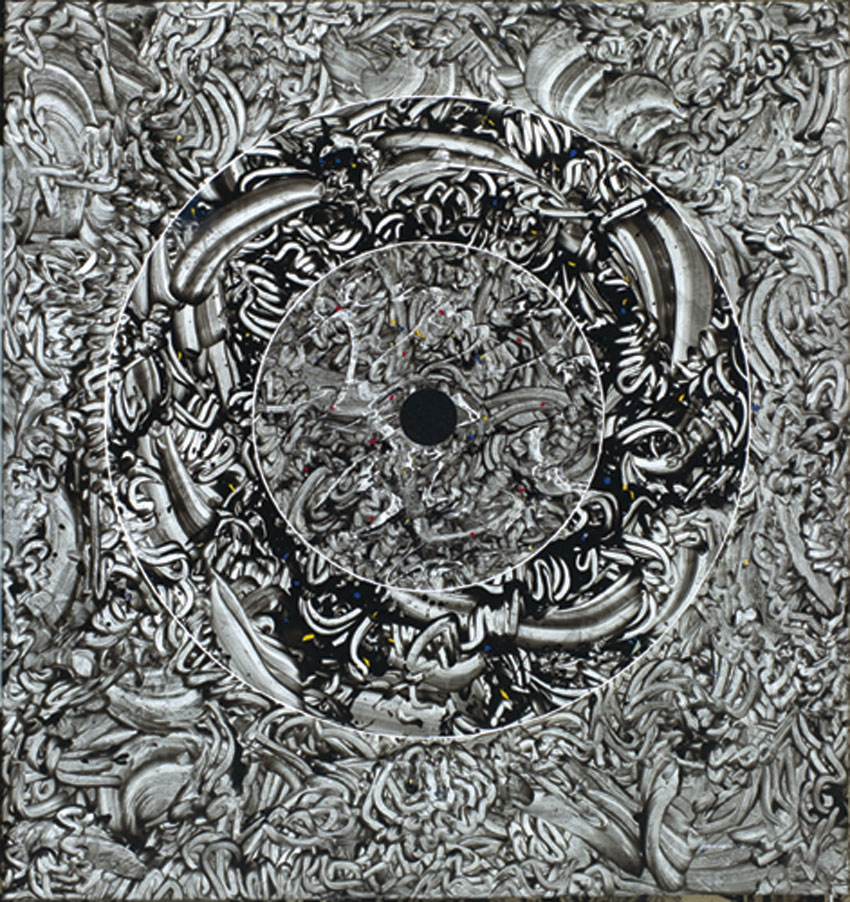Shows
“Written Images: Contemporary Calligraphy from the Middle East”


A showing of contemporary Arabic calligraphy at Sundaram Tagore Gallery’s Hong Kong location is a reprise of an exhibition of the same name at its sister gallery in New York in 2011. The works on display are by 15 artists from the Maghreb and Middle East, ranging from the forerunners of contemporary calligraphy, who came to prominence in the 1960s and 1970s—Nja Mahdaoui (b. 1937), Hassan Massoudy (b. 1944) and Ahmed Moustafa (b. 1943)—to a younger generation, including Golnaz Fathi (b. 1972) and Lulwah al-Homoud (b. 1967).
Arabic calligraphy, embodying the divine word in Islam, traditionally quotes verses from the Quran, the Hadith (or “Traditions of the Prophet Mohammed”) and Arabic proverbs. It was only in the 1960s and 1970s, with the influence of Abstract Expressionism and Cubism, that the 1,400-year-old art form shed some of its sacramental and semantic associations in the practice of modern artists.

“Written Images” presents a mini-survey of the expressive possibilities in contemporary Arabic calligraphy. Many of the works on show deconstruct the written language into abstract, even illegible shapes that emphasize the structural aesthetic above all else. Others, inspired by Sufist philosophy, focus on the symbolic and mystical associations of Arabic letters, so that a single letter may possess an entire meaning, while the thing denoted by a word or phrase becomes secondary.
Lebanese artist Chaouki Chamoun is among the artists whose work focuses on morphology and composition. Chamoun’s roughly 1.5-by-1.5 meter In the Beginning was the Search for the Word (2011) expresses the chaotic bewilderment in the moment before one finds verbal expression for some new emotion. The acrylic painting features three diminishing concentric circles, resembling a diagrammatic eye. Between the canvas’s edges and the outer circle, a chaotic layering of script has been drawn into the wet black paint until, if the glyphs held any meaning, they have been rendered indecipherable. This layering is repeated separately in the outer and inner ring created by the hard-edged circles, while the innermost circle (or pupil) is painted completely black. In addition, several dots of primary colors are placed carefully around the center of the canvas.

Conversely, the script in Egyptian Ahmed Moustafa’s colorful inkjet print on cotton, Night Journey and Ascension (2011), while stylized, remains legible. In this case, the shapes of the Arabic letters visually reiterate the words they compose, giving the work both immediacy and depth of meaning. Night Journey and Ascension expresses the titular Quranic verse describing prophet Mohammed’s journey from Mecca to Jerusalem, where he encounters the divine realm. The verse is repeated multiple times, like a mantra, one on top of the other, in undulating curves. A line from each character extends to the top of the canvas, the composition resembling swaying willow branches petrified in time. The print’s cool, radiant colors impart an additional, ethereal quality to the verse.
Saudi artist Lulwah al-Homoud does away completely with any recognizable script in her geometric cryptogram The Infinite Cube (Blue) (no year given). Informed by the Vedic square in Islamic geometry, al-Homoud contrived an algorithm to create her own model of the universe in Infinite Cube, a simple design of four white, intersecting squares on a blue ground. The resultant form, a kind of square spring, seems to spiral both backward and forward in space, and the eye, tracing any line, is swiftly drawn to the center of the composition. Because each Arabic letter is associated with a numeric value in the Abjad numeral system, Infinite Cube can also be viewed as a visual utterance or breath of life, which, for the artist, contains within it the first nine stages in the creation of humanity.
Contrary to expectation, rather than reducing the written word to pure form in the name of artistic expression, the artists in “Written Images” elaborate the profound relationship between image and word. (Every language in the earliest civilizations began as pictograms, symbols or sequential, narrative art.) “Written Images” can be appreciated for its visuals alone, but a fuller meaning is gained by viewing the exhibition as a grouping of artists’ investigations of the Arabic language in their search for an epistemological aesthetic or (in al-Homoud’s case) an intelligible geometry.







